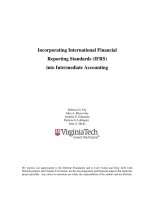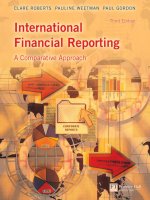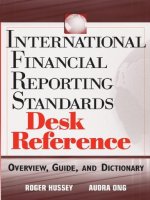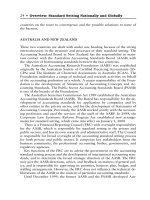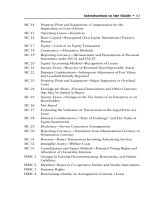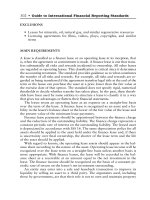International Financial Reporting Standards (IFRS): An AICPA Backgrounder doc
Bạn đang xem bản rút gọn của tài liệu. Xem và tải ngay bản đầy đủ của tài liệu tại đây (354.52 KB, 16 trang )
1
An AICPA Backgrounder
International Financial
Reporting Standards (IFRS)1
Table of Contents
Get Ready for IFRS 2
Worldwide Momentum 2
SEC Leadership in International Effort 3
The SEC Work Plan 4
FASB and IASB Convergence Efforts 5
AICPA Participation 7
Two Sides of the Story 7
Differences Remain Between U.S. GAAP and IFRS 8
What CPAs Need To Know 8
Appendix 10
Organizations Involved 12
2
Get Ready for IFRS
The growing acceptance of International
Financial Reporting Standards (IFRS) as a
basis for U.S. financial reporting represents a
fundamental change for the U.S. accounting
profession. The number of countries that
require or allow the use of IFRS for the
preparation of financial statements by publicly
held companies has continued to increase. In
the United States, the Securities and Exchange
Commission (SEC) is taking steps to determine
whether to incorporate IFRS into the financial
reporting system for U.S. issuers and, if so,
when and how.
Worldwide Momentum
The international standard-setting process
began several decades ago as an effort by
industrialized nations to create standards
that could be used by developing and
smaller nations unable to establish their own
accounting standards. But as the business
world became more global, regulators,
investors, large companies and auditing firms
began to realize the importance of having
common standards in all areas of the financial
reporting chain.
In a survey conducted in late 2007 by the
International Federation of Accountants
(IFAC), a large majority of accounting leaders
from around the world agreed that a single
set of international standards is important for
economic growth. Of the 143 leaders from
91 countries who responded, 90% reported
that a single set of international financial
reporting standards was “very important”
or “important” for economic growth in
their countries.
3
1
The European Union (EU) has
adopted virtually all International
Financial Reporting Standards
(IFRSs), though there is a time lag
in adopting several recent IFRSs.
In the EU, the audit report and
basis of presentation note refer
to compliance with “IFRSs as
adopted by the EU.”
2
Israel requires IFRS for all
companies, except banks and
companies dually listed in the
U.S. and Israel. Dually listed
companies have the option to
use IFRS or U.S. GAAP. Australia
and New Zealand have adopted
national standards that they
describe as IFRS-equivalents.
Currently, more than 120 nations and
reporting jurisdictions permit or require
IFRS for domestic listed companies. The
European Union (EU) requires companies
incorporated in its member states whose
securities are listed on an EU-regulated stock
exchange to prepare their consolidated
financial statements in accordance with
IFRS.
1
Australia, New Zealand and Israel have
essentially adopted IFRS as their national
standards.
2
Brazil started using IFRS in 2010.
Canada adopted IFRS, in full, on Jan. 1, 2011.
Mexico will require adoption of IFRS for
all listed entities starting in 2012. Japan is
working to achieve convergence of IFRS
and began permitting certain qualifying
domestic companies to apply IFRS for fiscal
years beginning April 1, 2010. A decision
regarding the mandatory use of IFRS in
Japan is to be made around 2012. Hong
Kong has adopted national standards
that are equivalent to IFRS and China is
converging its accounting standards with
IFRS. Other countries have plans to adopt
IFRS or converge their national standards
with IFRS.
In addition to the support received from
certain U.S based entities, financial
and economic leaders from various
organizations have announced their
support for global accounting standards.
Leaders of the Group of 20 (G20) called for
global accounting standards and urged the
U.S. Financial Accounting Standards Board
(FASB) and the International Accounting
Standards Board (IASB) to complete their
convergence projects in 2011. A summary
of the IASB and FASB’s efforts regarding
convergence is subsequently described.
SEC Leadership in
International Effort
The Securities and Exchange Commission
has for many years been a strong leader in
international efforts to develop a core set
of accounting standards that could serve
as a framework for financial reporting in
cross-border offerings. It has repeatedly
made the case that issuers wishing to raise
capital in more than one country are faced
with the increased compliance costs and
inefficiencies of preparing multiple sets of
financial statements to comply with different
jurisdictional accounting requirements. In
2000, the International Organization of
Securities Commissions (IOSCO), in which the
SEC plays a leading role, recommended that
its members allow multinational issuers to
use 30 “core” standards issued by the IASB’s
predecessor body in cross-border offerings
and listings.
A few years later, the SEC announced its
support of a Memorandum of Understanding
— the Norwalk Agreement — between
the FASB and the IASB. This agreement,
concluded in Norwalk, CT, established a
joint commitment to develop compatible
accounting standards that could be used for
both domestic and cross-border financial
reporting. In a subsequent Memorandum of
Understanding in September 2008, the FASB
and the IASB agreed that a common set of
high-quality, global standards remained their
long-term strategic priority and established
a plan to align the financial reporting of
U.S. issuers under U.S. generally accepted
accounting principles (GAAP) with that of
companies using IFRS.
4
2002
SEC announces support of Norwalk Agreement
between the Financial Accounting Standards
Board (FASB) and the International Accounting
Standards Board (IASB).
In 2007, the SEC unanimously voted to
allow foreign private issuers to file financial
statements prepared in accordance with IFRS
as issued by the IASB without reconciliation
to U.S. GAAP. Of even greater importance
was the SEC’s Concept Release seeking input
on allowing U.S. public companies to use
IFRS when preparing financial statements. In
November 2008, the SEC issued a proposed
roadmap that included seven milestones for
continuing U.S. progress toward acceptance
of IFRS. The roadmap generated significant
interest and thoughtful comments from
investors, issuers, accounting firms, regulators
and others regarding factors the SEC
should consider.
On Feb. 24, 2010, the SEC issued Release
Nos. 33-9109 and 34-61578, Commission
Statement in Support of Convergence and
Global Accounting Standards, in which
the SEC stated its continued belief that a
single set of high-quality globally accepted
accounting standards would benefit U.S.
investors and expressed encouragement for
the continued convergence of U.S. GAAP
and IFRS. The releases also called for the
development and execution of a “work plan”
to enhance both the understanding of the
SEC’s purpose and public transparency in
regard to IFRS. The work plan addresses many
of the areas of concern highlighted in the
comment letters to the 2008 roadmap.
The SEC Work Plan
The work plan includes consideration of IFRS,
both as they currently exist and after the
completion of the various convergence projects
under way by the FASB and the IASB. Among
other things, the work plan addresses some
of the comments and concerns received in
response to the SEC’s proposed roadmap issued
in November 2008, including the following:
1988
Securities and Exchange
Commission (SEC) issues a
policy statement supporting
the establishment of
mutually acceptable
international accounting
standards.
1997
SEC encouraged the
efforts of the International
Accounting Standards
Committee to develop
a core set of accounting
standards. These standards
are now known as IFRS.
2007
SEC votes unanimously to accept
from foreign private issuers
financial statements prepared
in accordance with IFRS without
reconciliation to U.S. GAAP.
2008
SEC issues proposed roadmap with timeline and key
milestones for moving to IFRS and allowing early adoption
for U.S. public companies meeting certain criteria.
SEC Timeline
2010
SEC issues a statement in support of convergence
and global accounting standards and calls for the
development and execution of a work plan. SEC
issues work plan progress report on Oct. 29.
1989
1991 1993 1995 1997 1999 2001 2003 2005 2007
1988
1990
1992
1994 1996 1998
2000 2002 2004 2006
2008
2009
2010
5
Determining whether IFRS is sufficiently
developed and consistent in application
for use as the single set of accounting
standards in the U.S. reporting system
Ensuring that accounting standards are set
by an independent standard setter and for
the benefit of investors
Investor understanding and education
regarding IFRS and how it differs from
U.S. GAAP
Understanding whether U.S. laws or
regulations, outside of the securities laws
and regulatory reporting, would be affected
by a change in accounting standards
Understanding the impact on companies
both large and small, including changes to
accounting systems, changes to contractual
arrangements, corporate governance
considerations and litigation contingencies
Human capital readiness – determining
whether the people who prepare and audit
financial statements are sufficiently
prepared, through education and
experience, to convert to IFRS
On Oct. 29, 2010, the SEC released a progress
report on its IFRS Work Plan. The report
provided details on progress and remaining
research and analysis to be done as the SEC
considers whether to incorporate IFRS into the
U.S. financial reporting system for U.S. issuers.
In 2011, assuming completion of the
convergence projects and the SEC staff’s
work plan, the SEC will decide whether
to incorporate IFRS into the U.S. financial
reporting system for U.S. issuers, and if
so, when and how. If the SEC determines
to incorporate IFRS into the U.S. financial
reporting system, the SEC believes the first
time U.S. entities would be required to report
under such a system would be no earlier than
2015. This timeline will be further evaluated
as part of the work plan. The work plan is
included as an appendix at the end of the
SEC’s release, which is located on the SEC’s
website at the following address: sec.gov/
rules/other/2010/33-9109.pdf.
Additional information, including the
SEC’s progress report, can be found at
the following address: sec.gov/spotlight/
globalaccountingstandards.shtml.
FASB and IASB
Convergence Efforts
The FASB and the IASB have been working
together toward convergence since 2002. The
two boards have described what convergence
means and their tactics to achieve it in two
documents — the Norwalk Agreement issued in
2002 and the Memorandum of Understanding
(MoU), originally issued in 2006 and updated in
2008. The MoU originally highlighted several
major convergence projects between IASB and
FASB scheduled for completion in 2011. In
response to the requests from the leaders of the
G20, the IASB and FASB published a progress
report, describing an intensification of their
work program, including monthly joint board
meetings and quarterly progress updates on
these convergence projects.
On Nov. 29, 2010, FASB and IASB issued a
convergence progress report. In the report, the
standard setters reaffirmed their priority projects
for completion by June 30, 2011, or earlier. Joint
priority projects include financial instruments,
6
revenue recognition, leases, presentation of
other comprehensive income and fair value
measurement. For the IASB, projects scheduled
for completion by the end of June 2011 include
improved disclosures about derecognized assets
and other off-balance sheet risks, consolidations
and its project on insurance contracts.
The boards decided to defer until after June
2011 substantive deliberations on four projects
including the broader financial statement
presentation project, financial instruments with
characteristics of equity, emissions trading
schemes and the reporting entity phase of the
conceptual framework. The boards also agreed
that consolidation of investment companies is
no longer a priority for June 2011.
The FASB and IASB also deferred deliberations
on several of their independent standard-setting
projects (such as contingency disclosures for
the FASB and IAS 37 Provisions, Contingent
Liabilities and Contingent Assets and annual
improvements for the IASB).
Of the remaining original projects in the
2006 MoU, Business Combinations has been
completed. Intangible Assets has been removed
from the active agendas of both boards and
Post-Employment Benefits was removed
from the list of priority MoU projects in
October 2009.
For more information on convergence, visit the
Convergence Section of IFRS.com.
7
AICPA Participation
The AICPA was a charter member of the
International Accounting Standards Committee
(IASC), the IASB’s predecessor organization.
In the three decades since, the AICPA has
worked to advance international convergence
of accounting standards.
The AICPA provides thought leadership to the
IASB on financial reporting topics. The Institute
has made clear its support for the goal of a
single set of high-quality, global accounting
standards to be used by public companies in
the preparation of transparent and comparable
financial reports throughout the world and
believes the standards issued by the IASB are
best positioned to become those standards. In
response to the SEC’s endorsement of a work
plan, as previously mentioned, Barry Melancon,
AICPA President and Chief Executive Officer,
reiterated the AICPA’s continued support
of the “thoughtful and concrete steps the
SEC is taking” to prepare for the possible
transition to IFRS. The AICPA also is committed
to supporting the nation’s CPAs — largely
financial statement preparers, auditors and
educators — through an orderly transition.
Mindful of the importance of private companies
and not-for-profit organizations, AICPA Council
on May 18, 2008, voted to recognize the
IASB as an international accounting standard
setter under Rules 202 and 203 of the Code
of Professional Conduct. Appendix A to Rules
202 and 203 of the AICPA’s Code of Ethics
sets forth the standard setters that have been
designated by the Council. Under Rule 202, a
member who performs professional services
shall comply with the standards promulgated
by the designated bodies. Additionally,
a member may not say that financial
statements are in accordance with generally
accepted accounting principles unless they
follow the standards promulgated by a
standard setter listed in Appendix A of Rule
203. By removing a potential barrier, private
companies and not-for-profit organizations
have a clear option to decide if following
IFRS makes sense for their situations and
financial reporting constituents.
Two Sides of the Story
Growing interest in the global acceptance of
a single set of robust accounting standards
comes from all participants in the capital
markets. Many multinational companies
and national regulators and users support
it because they believe that the use of
common standards in the preparation of
public company financial statements will make
it easier to compare the financial results of
reporting entities from different countries.
They believe it will help investors understand
opportunities better. Large public companies
with subsidiaries in multiple jurisdictions would
be able to use one accounting language
company-wide and present their financial
statements in the same language as
their competitors.
Another benefit some believe is that in a
truly global economy, financial professionals,
including CPAs, will be more mobile, and
companies will more easily be able to respond
to the human capital needs of their subsidiaries
around the world. Recent SEC actions and
global trends have increased awareness of the
need to address possible adoption.
8
The AICPA conducts a semi-annual IFRS
Readiness Survey. In its fall 2010 survey, 54%
of respondents said that the SEC should
ultimately require adoption of IFRS for U.S.
public companies, although most believe
more convergence of accounting standards is
needed first. Another 21% said IFRS should be
available as an option for use by U.S. public
companies. A survey of more than 2,500
executives by global accounting firm KPMG,
taken subsequent to the SEC’s February 2010
Work Plan release, found that 49% of U.S.
executives want the option to move to IFRS
earlier than the SEC 2015 potential adoption
date, if the SEC makes a decision in 2011 to
allow IFRS for U.S. issuers. Nevertheless, many
people also believe that U.S. GAAP is the
gold standard, and some degree of quality will
be lost with full acceptance of IFRS. Another
concern is that worldwide, many countries
that claim to be converging to international
standards may never get to 100% compliance.
Most reserve the right to carve out selectively
or modify standards they do not consider in
their national interest, an action that could lead
to incomparability — the very issue that IFRS
seek to address.
Differences Remain
Between U.S. GAAP
and IFRS
Great strides have been made by the FASB
and the IASB to converge the content of IFRS
and U.S. GAAP. The goal is that by the time
the SEC allows or mandates the use of IFRS
for U.S. publicly traded companies, many key
differences will have been resolved.
Because of these ongoing convergence
projects, the extent of the specific differences
between IFRS and U.S. GAAP is shrinking. Yet
significant differences do remain. For example:
IFRS does not permit Last In First Out (LIFO)
as an inventory costing method.
IFRS allows the revaluation of assets in
certain circumstances.
IFRS uses a single-step method for
impairment write-downs rather than the
two-step method used in U.S. GAAP, making
write-downs more likely.
IFRS requires capitalization of development
costs, when certain criteria are met.
Perhaps the greatest difference between
IFRS and U.S. GAAP is that IFRS provides less
overall detail and industry-specific guidance.
What CPAs Need To Know
The increasing acceptance of IFRS, both in the
U.S. and around the world, means that now
is the time to become knowledgeable about
these changes. Most CPAs will somehow be
affected. Once a critical mass of non-U.S.
companies in a certain industry sector begins
to report their financial results using IFRS,
there will likely be pressure for U.S. issuers
to do the same, to allow investors to better
compare their financial results. But this issue
will have an impact far beyond just financial
reports. It will affect almost every aspect of a
U.S. company’s operations, everything from
its information technology systems, to its tax
reporting requirements, to the way it tracks
stock-based compensation.
9
For the CPA profession, the use of IFRS by U.S.
publicly held companies will create the need for
effective training and education. Companies will
use IFRS only if they and their auditors have been
thoroughly trained, and if their investors and
other users of their financial statements — such as
analysts and rating agencies — understand IFRS
as well. At the moment, most accountants in the
United States are trained in U.S. GAAP, not IFRS.
Most specialists, such as actuaries and valuation
experts, who are engaged by management to assist
in measuring certain assets and liabilities, also are
not experienced with IFRS. Consequently, all parties
will need to undertake comprehensive training.
Professional associations and industry groups will
need to integrate IFRS into their training materials,
publications, testing and certification programs.
Colleges and universities are including IFRS in their
curricula. In addition, the Uniform CPA Exam now
contains questions related to IFRS.
The bottom line is that CPAs need to begin to
prepare for the day in the not-so-distant future
when the SEC could designate a date for voluntary,
or even mandatory, adoption of IFRS by all U.S.
public companies.
The AICPA understands it will need to fulfill a number
of responsibilities to make the use of IFRS by public
companies a success. Ongoing efforts include:
Continuing to educate AICPA members about IFRS
Working with accounting educators, textbook
authors and educational institutions to prepare
future professionals to use IFRS
Making certain the voice of U.S. CPAs is heard
internationally
10
Appendix
Timeline for IFRS Acceptance in the United States
2001: The International Accounting Standards Board
(IASB) is established as the successor organization to
the International Accounting Standards Committee
(IASC), formed in 1973. The IASB’s mandate is to
develop International Financial Reporting Standards
(IFRS).
2002: The IASB and the Financial Accounting
Standards Board (FASB) issue the Norwalk Agreement,
acknowledging the joint commitment to developing
high-quality, compatible accounting standards that
could be used for both domestic and cross-border
financial reporting. Also, the European Union (EU)
announces that its member states will require IFRS in
the preparation of consolidated financial statements of
listed companies beginning in 2005.
2005: The chief accountant of the Securities and
Exchange Commission (SEC) releases a roadmap
allowing IFRS filings without U.S. GAAP reconciliation
for foreign firms by 2009, or earlier.
2006: The IASB and the FASB agree to work on
a number of major projects.
2007: The SEC announces that it will accept from
foreign filers in the U.S. financial statements prepared
in accordance with IFRS, as issued by the IASB, without
reconciliation to U.S. GAAP. Also, the SEC issues a
Concept Release asking if U.S. public companies
should be given an option to follow IFRS instead of
U.S. GAAP.
2008: The SEC issues a proposed roadmap that
includes milestones for continuing U.S. progress
toward acceptance of IFRS. The roadmap also would
allow early adoption of IFRS for U.S. public companies
that meet certain criteria. The AICPA’s governing
Council votes to recognize the IASB as an international
accounting standard setter under rules 202 and 203
of the Code of Professional Conduct, thereby giving
U.S. private companies and not-for-profit organizations
the choice to follow IFRS. Also, the FASB and the IASB
issue an updated Memorandum of Understanding
that focuses the energies of both boards toward
convergence of important accounting standards, such
as revenue recognition, leases and consolidation.
2009: The IASB ended its moratorium, set in 2005, on
the required application of new accounting standards
and major amendments to existing standards. The
board had frozen its rules while more countries
adopted IFRS. Japan introduces a roadmap that
could lead to a decision in 2012 to adopt IFRS, with
proposed adoption dates in 2015 or 2016.
2010: The SEC releases a staff Work Plan to evaluate
the effect that using IFRS would have on the U.S.
financial reporting system. The SEC notes 2015 is
currently the most likely first adoption year. Japan
allows certain qualifying domestic companies the
option to use IFRS for fiscal years ending on or after
March 31, 2010.
2011: Canadian and Indian companies begin using
the global standards, and Japan is slated to have
eliminated all major differences between Japanese
GAAP and IFRS. SEC to evaluate feasibility of requiring
use of IFRS based on completion of the outstanding
MoU items and on results of the 2010 staff Work Plan.
In the United States, questions concerning IFRS are
included in the Uniform CPA Exam.
2012: Mexico scheduled to adopt IFRS for all
listed entities.
2015: Earliest year the SEC would allow public
companies to convert their financials to IFRS.
11
2012
Mexico scheduled to adopt
IFRS for all listed entities.
2001
The International Accounting
Standards Board (IASB)
is established as the
successor organization to
the International Accounting
Standards Committee (IASC),
formed in 1973. The IASB’s
mandate is to develop
International Financial
Reporting Standards (IFRS).
2002
The IASB and the Financial Accounting
Standards Board (FASB) issue the Norwalk
Agreement, acknowledging the joint
commitment to developing high-quality,
compatible accounting standards that could
be used for both domestic and cross-border
financial reporting. Also, the European
Union (EU) announces that its member
states will require IFRS in the preparation of
consolidated financial statements of listed
companies beginning in 2005.
2001 2003 2005 2007 2009 2011 2013 2015
2000
2002 2004 2006
2008 2010 2012 2014
2016
2017
2015
Earliest year the
SEC would allow
public companies
to convert their
financials to IFRS.
IFRS Timeline
2005
The chief accountant of the Securities and
Exchange Commission (SEC) releases a
roadmap allowing IFRS filings without U.S. GAAP
reconciliation for foreign firms by 2009, or earlier.
2006
The IASB and the FASB agree to
work on a number of major projects.
2007
The SEC announces that it will
accept from foreign filers in the
U.S. financial statements prepared
in accordance with IFRS, as issued
by the IASB, without reconcilia-
tion to U.S. GAAP. Also, the SEC
issues a Concept Release asking
if U.S. public companies should
be given an option to follow IFRS
instead of U.S. GAAP.
2011
Canadian and Indian companies begin using
the global standards, and Japan is slated to
have eliminated all major differences between
Japanese GAAP and IFRS. SEC to evaluate
feasibility of requiring use of IFRS based on
completion of the outstanding MoU items
and on results of the 2010 staff Work Plan. In
the United States, questions concerning IFRS
are included in the Uniform CPA Exam.
2009
The IASB ended its moratorium, set in 2005, on the required
application of new accounting standards and major amendments
to existing standards. The board had frozen its rules while more
countries adopted IFRS. Japan introduces a roadmap that
could lead to a decision in 2012 to adopt IFRS, with proposed
adoption dates in 2015 or 2016.
2008
The SEC issues a proposed roadmap that includes
milestones for continuing U.S. progress toward
acceptance of IFRS. The roadmap also would allow
early adoption of IFRS for U.S. public companies
that meet certain criteria. The AICPA’s governing
Council votes to recognize the IASB as an
international accounting standard setter under
rules 202 and 203 of the Code of Professional
Conduct, thereby giving U.S. private companies
and not-for-profit organizations the choice to follow
IFRS. Also, the FASB and the IASB issue an updated
Memorandum of Understanding that focuses
the energies of both boards toward convergence
of important accounting standards, such as
revenue recognition, leases and consolidation.
2010
The SEC releases a staff Work Plan to evaluate the effect
that using IFRS would have on the U.S. financial reporting
system. The SEC notes 2015 is currently the most likely first
adoption year. Japan allows certain qualifying domestic
companies the option to use IFRS for fiscal years ending
on or after March 31, 2010.
12
Organizations Involved
In April 2001, the International Accounting Standards Board (IASB), an independent accounting
standard setter based in London, assumed accounting standard-setting responsibilities from its
predecessor body, the International Accounting Standards Committee. The IASB is responsible
for International Financial Reporting Standards (IFRS).
The Securities and Exchange Commission (SEC), created in 1934 by an act of Congress, is the
U.S. government agency with primary responsibility for enforcing the federal securities laws and
regulating the securities industry and the U.S. stock market. For the past three decades, it has
become increasingly vocal in its support of a single set of robust accounting standards that would
be used worldwide.
The American Institute of Certified Public Accountants (AICPA) is the world’s largest organization
representing the accounting profession, with nearly 370,000 members in 128 countries. Well before
IFRS began to gain traction in the U.S. business and regulatory communities, the AICPA was publicly
supporting the goal of a single set of high-quality, global accounting standards to be used in the
financial reporting of public companies throughout the world.
The Financial Accounting Standards Board (FASB) is working with the IASB to converge their
respective accounting standards into a robust set of rules that will meet the needs of preparers
and users worldwide.
The AICPA’s Financial Reporting Executive Committee (FinREC) is the senior technical committee
of the AICPA authorized to speak on accounting matters. It provides accounting guidance to help
financial professionals discharge their duties and serve the public interest.
For More Information:
American Institute of CPAs aicpa.org
Financial Accounting Standards Board fasb.org
International Accounting Standards Board iasb.org
International Federation of Accountants ifac.org
AICPA IFRS Resources ifrs.com
International Organization of Securities Commissions iosco.org
Securities and Exchange Commission sec.gov/spotlight/globalaccountingstandards.shtml
SEC Release Nos. 33-9109 and 34-61578 sec.gov/rules/other/2010/33-9109.pdf
13
DISCLAIMER: This publication has not been approved, disapproved or otherwise acted upon by any senior technical committees
of, and does not represent the official position of, the American Institute of Certified Public Accountants. It is distributed with
the understanding that the contributing authors and editors, and the publisher, are not rendering legal, accounting, or other
professional services in this publication. If legal advice or other expert assistance is required, the services of a competent
professional should be sought.
Copyright © 2011 American Institute of CPAs
All rights reserved. Any reprinting, copying or reuse of this document in whole or in part without the express written permission from
the AICPA is strictly prohibited. Requests for permission to copy, reprint, republish or reuse all or any part of this work should be
directed to Manager-Rights and Permissions, AICPA, 220 Leigh Farm Road, Durham, NC 27707. Direct inquiries to +1.919.402.4031.
14
T: 888.777.7077 | F: 800.362.5066 | ifrs.com
11046-347



